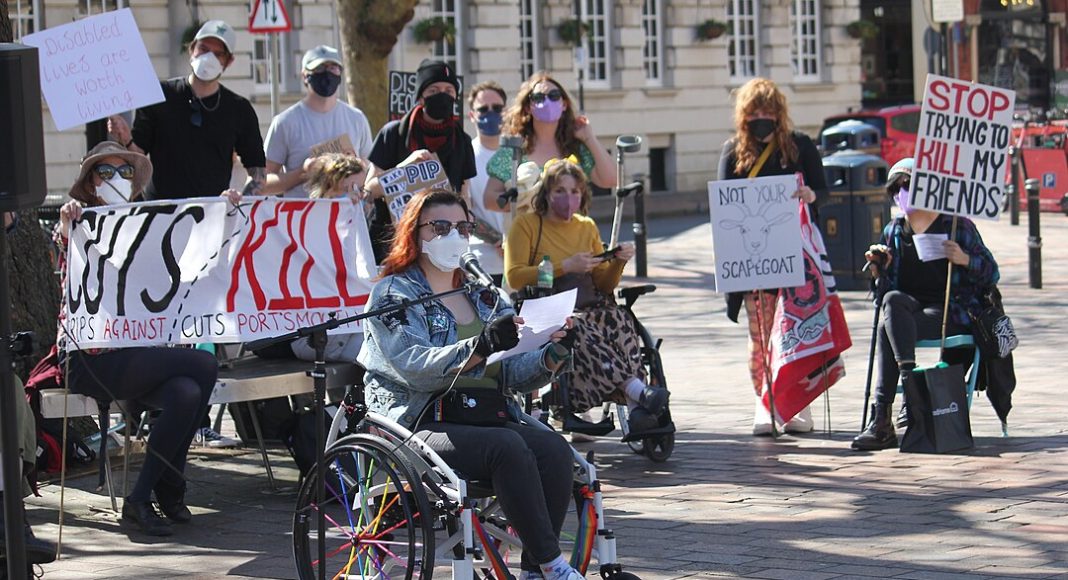On 11 June, Chancellor Rachel Reeves announced a Spending Review 2025 which included the cuts in disability benefits heralded in the March Green Paper. With financiers greedily calculating both the state’s debts and interest owed to them, Reeves was confronted by Labour MPs fearing for their seats and who would finally force a partial block on planned cuts to disability benefits. JAMES MARTIN reports.
Rather than a plain restatement of the November 2024 budget plans, the Spending Review was upset by the widespread reaction to an attempted £5bn raid on disability benefits from the most vulnerable section of the working class, announced in the March Green Paper. A revolt by Labour MPs rejected this attempt only 11 working days after the Spending Review itself.
Mental health
1.3 million people now claim disability benefits, primarily for mental health conditions – 44% of all claimants. 86% of incapacity and disability benefit claimants reported having a mental health condition – even if it was not their primary condition (Department for Work and Pensions).
Following the pandemic of 2020-21, the number of 16- to 64-year-olds in England and Wales on disability benefits has risen by 0.9 million to 2.9 million, with 7.5% of 16- to 64-year-olds now claiming. Around 0.5 million – over half – of this rise has come from claimants whose main condition is a mental health problem (Joseph Rowntree Foundation and the Health Foundation). 13-15% of the working-age population reported a long-term mental or behavioural health condition in the latest data, up from 8-10% in the mid-2010s. Since 2019, there has also been a 12% increase in the number of people in England receiving antidepressants. Sickness absence rates increased by 29% for teachers, 19% in the Civil Service and 14% in the NHS over this period. After adjusting for changing population size and ageing, there were 3,700 (24%) more working-age ‘deaths of despair’ (deaths due to alcohol, drugs or suicide) in 2023 than the 2015-19 average. The Labour government has decided that this is little more than an excuse not to work.
Labour MPs panic
The attack on three million recipients threw many Labour MPs into a panic, mortified at the thought of the loss of their constituencies. With a continued row over the maintenance of the Conservative government’s two-child benefit cap and the regular revelations of the extent of child poverty, embarrassed Labour MPs were forced to put up a noisy show of protest for their electors.
Together, the scandalous removal of the Winter Fuel Payment from pensioners announced on 29 July last year, which removed 10.3 million pensioners from this benefit, and the March announcements of the Personal Independent Payment/Universal Credit (PIP/UC) cuts, certainly caused the loss of Labour seats in the April 2025 local elections. In reaction, on 20 May the Winter Fuel Payment was largely reestablished. Only the quarter of pensioners with more than a £35,000 per year taxable income is now excluded. This saves the government only £450m, rather than the £1.4bn it had aimed for. On 18 June Starmer further announced that the Warm Home Discount – a one-off £150 discount on electricity bills for eligible low-income households – was being extended to 6 million homes from the previous 3.3 million.
On 25 June Labour’s sly Health Secretary Wes Streeting announced the reallocation of £2.2bn from England’s 215 health trusts, originally aimed to plug their budget deficits, to deprived and coastal areas, to close the service gap with ‘well-off’ areas. The NHS Chief Executive was now forced to order the health trusts to ‘balance their books’ – making their own cuts. Streeting is really concerned to recoup the estimated £31bn a year in lost productivity from sickness, and up to £32bn a year in lost tax and benefit payments. Despite Reeve’s attempts, on the evening of 25 June, to persuade MPs to support the PIP/UC cuts, Downing Street backed down the next day.
On 1 July, the government, having failed to browbeat 120 of its 398 MPs, removed part of its cuts in the Universal Credit and Personal Independence Payment Bill. At its final 9 July Commons reading, the proposed four-point test for each single activity to permit PIP entitlement – disadvantaging those with complex limitations – was reset to apply only to new claimants from November 2026. This creates a two-tier universal credit system. The government was also forced to increase the rate of the UC ‘health’ element for those already entitled to it, and for those who meet the ‘severe conditions’ criteria. The four-year freeze to the amount paid to both new and existing claimants was also removed.
To blunt further protests, the government cynically promised a review of the PIP assessment by its own DWP Minister Stephen Timms before any future PIP eligibility changes, and brought forward the previously promised ‘employment support measures’. However, the serious cut to the disability support in UC from April 2026 remains in the Bill, with fewer safeguards in place. Most new claimants face a cut of just over £200 a month – a reduction to the disability support of almost half.
Many people with myalgic encephalomyelitis/chronic fatigue syndrome or Long Covid may fall outside protected groups and lose access to extra support if they do not meet new, stricter eligibility rules. Disabled people with lower care or mobility needs, younger claimants, or those newly disabled, will certainly lose out. Some households could lose over £10,000 per year, especially if both PIP and UC health top-ups are lost.
To calm the dissent provoked by all her previous budgeting decisions, on 14 July Reeves expanded her ‘life chances’ fund from £70m to £500m for charities to use in youth programmes. Ridiculously, she expressed the belief that a complementary £500m would magically be made available from already desperate local governments and cash-strapped charities themselves.
The November 2024 Budget had already fixed capital and current spending for 2026-29, based on miserable capital accumulation forecasts. From 2024 until 2030 the planned cumulative change in government department spending budgets was for a fall of some 15%, but the MPs’ continued welfare payments rebellion described above has led to a cumulative £6.25bn spanner in the works. This has made it even more important for the state to emphasise its militarisation strategy as a key to its economic growth policy.
Military spending
For the Labour Party, the 11 June Spending Review began with state ‘security’, adding £2.2bn to raise the defence budget to £56.9bn in 2024/25. In a February 2025 announcement, defence spending was to be increased to 2.6% of GDP from 2027 and subsequently pushed to 3%. This incorporated the already existing ‘intelligence’ costs – so padding out the ‘defence’ category by sleight of hand, to influence other NATO members to increase arms spending – plus those of the new (July 2024) Border Security Command (BSC). The BSC aims chiefly at controlling migrant entry strictly in the interests of British capitalism’s labour requirements. On 24 June Starmer announced the expansion of British imperialism’s nuclear weapons delivery capacity. Starmer also announced an increase in defence spending commitment to 5% GDP from 2035.
The Labour Party’s 10-year Health Plan supposedly includes three ‘shifts’ – more community care, more digital, more on prevention, yet the shift of capital spending to armaments will now make this impossible, unless, of course, taxes increase in November.
While military spending is creating a profit boom for arms manufacturers, any increase in productivity here cannot provide cheaper consumer goods which would reduce the real costs of labour power and raise the general rate of exploitation. Only with the foreign currency earned by exporting weapons can cheaper consumer products be imported, real wages reduced, and overall domestic rates of profit raised. This is why such industries in Britain are so strongly encouraged by the state to focus on exports.
Capital spending
The Department for Education capital spending limit was £7.5bn in 2009/10 and was cut in cash terms by the previous government. It is now only £6.1bn. It will not exceed these 2009/10 funding levels until 2026/7. However, ‘Justice’ will get £7bn towards building new prisons for an anticipated further 14,000 prisoners, a clear sign of the government’s expectations of social breakdown and resistance.
Housing is to receive £39bn for the Affordable Homes Programme over 10 years, aiming for 300,000 new builds a year (the same as the Conservative government’s 2019 promise), including 180,000 for social rent. Construction specialists commonly calculate that this target will be failed by 40%. In March 2024, there were 1.33 million households on local authority housing waiting lists and 127,890 households in England in temporary accommodation.
Current spending
The picture remains exceptionally grim for Local Authorities (LAs), the majority permitted to raise Council Tax by 4.9% a year. The aim is to make LA finances 80% dependent on local residents by 2028-29, shifting the ‘burden’ from central government. Business rates, on the other hand, are being relieved by 40% for retail, hospitality, and leisure properties up to £110,000 in 2025-26, and permanently reduced in 2026-27. This move deliberately excludes businesses run by local authorities. For the moment LAs will be reimbursed for these business subsidies by central government. The government grant to LAs sees no real-term increases for 2027-28 and 2028-29. LA funding will still be 10% lower per person in 2028-29 than it was in 2010! Councils continue to be squeezed, while tax is diverted to subsidise private operators.
LAs already face huge deficits for their Special Educational Needs (SEND) programmes. The annual cost of SEND is already more than the funding available, and it is predicted that cumulative unfunded SEND costs will be £6bn by end of March 2026. The bubbling crisis in LA finances is a chronic issue, and debt write-offs will be forced on the Chancellor.
For child care entitlements the spending review provided a top-up of only £625m to cover part of the £1bn increased real costs. The needed balance is passed to school nursery provision, simply rearranging the limited cash. School budgets are frozen in real terms.
Capitalism’s choice: stagnation or oppression
Given the continuous need to extract more profit, for the ‘growth’ of private wealth, the ruling class has no choice but to continue with severe restraint, and preferably absolute cuts, in state spending, especially the so called ‘social wage’. This is that part of wages taxed and redistributed across the working class to maintain the minimum standards of health and education necessary for capital accumulation. The 40-year-long privatisation campaigns will not be abandoned, since they are a lever to replace state welfare with private payments. Restricted ‘nationalisations’ are permitted only where key industries stagnate, or collapse, until fully profitable operations can be reimposed.
Private investors fret that the state budget deficit exceeds 5% of GDP and its debt to GDP ratio is close to 100%. On 8 July the Office of Budget Responsibility stated that with no change to policy, by the 2070s, annual state borrowing may rise to 20% of GDP and the debt ratio to 270%. For capitalism this is a dead end, and its continuously intensifying attack on the working class is the only way it can continue to exist.
Fight Racism! Fight Imperialism! 307, August/September 2025




